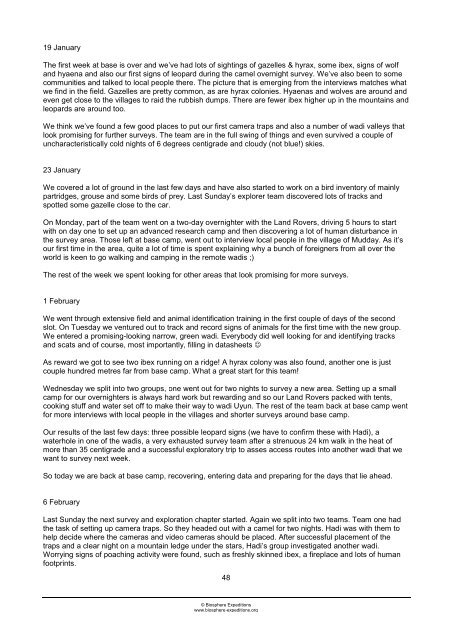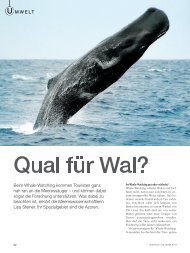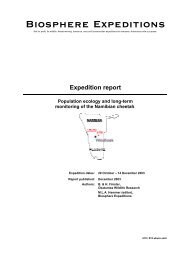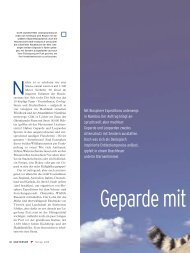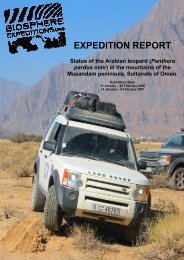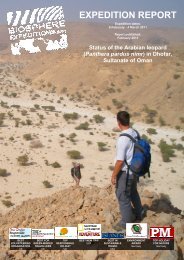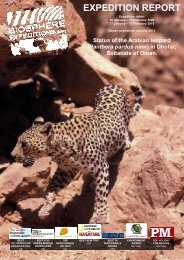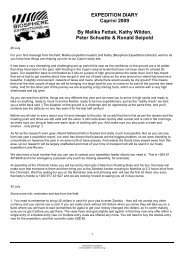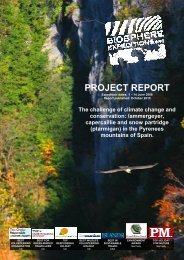Status of the Arabian leopard Panthera pardus nimr - Biosphere ...
Status of the Arabian leopard Panthera pardus nimr - Biosphere ...
Status of the Arabian leopard Panthera pardus nimr - Biosphere ...
You also want an ePaper? Increase the reach of your titles
YUMPU automatically turns print PDFs into web optimized ePapers that Google loves.
19 January<br />
The first week at base is over and we’ve had lots <strong>of</strong> sightings <strong>of</strong> gazelles & hyrax, some ibex, signs <strong>of</strong> wolf<br />
and hyaena and also our first signs <strong>of</strong> <strong>leopard</strong> during <strong>the</strong> camel overnight survey. We’ve also been to some<br />
communities and talked to local people <strong>the</strong>re. The picture that is emerging from <strong>the</strong> interviews matches what<br />
we find in <strong>the</strong> field. Gazelles are pretty common, as are hyrax colonies. Hyaenas and wolves are around and<br />
even get close to <strong>the</strong> villages to raid <strong>the</strong> rubbish dumps. There are fewer ibex higher up in <strong>the</strong> mountains and<br />
<strong>leopard</strong>s are around too.<br />
We think we’ve found a few good places to put our first camera traps and also a number <strong>of</strong> wadi valleys that<br />
look promising for fur<strong>the</strong>r surveys. The team are in <strong>the</strong> full swing <strong>of</strong> things and even survived a couple <strong>of</strong><br />
uncharacteristically cold nights <strong>of</strong> 6 degrees centigrade and cloudy (not blue!) skies.<br />
23 January<br />
We covered a lot <strong>of</strong> ground in <strong>the</strong> last few days and have also started to work on a bird inventory <strong>of</strong> mainly<br />
partridges, grouse and some birds <strong>of</strong> prey. Last Sunday’s explorer team discovered lots <strong>of</strong> tracks and<br />
spotted some gazelle close to <strong>the</strong> car.<br />
On Monday, part <strong>of</strong> <strong>the</strong> team went on a two-day overnighter with <strong>the</strong> Land Rovers, driving 5 hours to start<br />
with on day one to set up an advanced research camp and <strong>the</strong>n discovering a lot <strong>of</strong> human disturbance in<br />
<strong>the</strong> survey area. Those left at base camp, went out to interview local people in <strong>the</strong> village <strong>of</strong> Mudday. As it’s<br />
our first time in <strong>the</strong> area, quite a lot <strong>of</strong> time is spent explaining why a bunch <strong>of</strong> foreigners from all over <strong>the</strong><br />
world is keen to go walking and camping in <strong>the</strong> remote wadis ;)<br />
The rest <strong>of</strong> <strong>the</strong> week we spent looking for o<strong>the</strong>r areas that look promising for more surveys.<br />
1 February<br />
We went through extensive field and animal identification training in <strong>the</strong> first couple <strong>of</strong> days <strong>of</strong> <strong>the</strong> second<br />
slot. On Tuesday we ventured out to track and record signs <strong>of</strong> animals for <strong>the</strong> first time with <strong>the</strong> new group.<br />
We entered a promising-looking narrow, green wadi. Everybody did well looking for and identifying tracks<br />
and scats and <strong>of</strong> course, most importantly, filling in datasheets <br />
As reward we got to see two ibex running on a ridge! A hyrax colony was also found, ano<strong>the</strong>r one is just<br />
couple hundred metres far from base camp. What a great start for this team!<br />
Wednesday we split into two groups, one went out for two nights to survey a new area. Setting up a small<br />
camp for our overnighters is always hard work but rewarding and so our Land Rovers packed with tents,<br />
cooking stuff and water set <strong>of</strong>f to make <strong>the</strong>ir way to wadi Uyun. The rest <strong>of</strong> <strong>the</strong> team back at base camp went<br />
for more interviews with local people in <strong>the</strong> villages and shorter surveys around base camp.<br />
Our results <strong>of</strong> <strong>the</strong> last few days: three possible <strong>leopard</strong> signs (we have to confirm <strong>the</strong>se with Hadi), a<br />
waterhole in one <strong>of</strong> <strong>the</strong> wadis, a very exhausted survey team after a strenuous 24 km walk in <strong>the</strong> heat <strong>of</strong><br />
more than 35 centigrade and a successful exploratory trip to asses access routes into ano<strong>the</strong>r wadi that we<br />
want to survey next week.<br />
So today we are back at base camp, recovering, entering data and preparing for <strong>the</strong> days that lie ahead.<br />
6 February<br />
Last Sunday <strong>the</strong> next survey and exploration chapter started. Again we split into two teams. Team one had<br />
<strong>the</strong> task <strong>of</strong> setting up camera traps. So <strong>the</strong>y headed out with a camel for two nights. Hadi was with <strong>the</strong>m to<br />
help decide where <strong>the</strong> cameras and video cameras should be placed. After successful placement <strong>of</strong> <strong>the</strong><br />
traps and a clear night on a mountain ledge under <strong>the</strong> stars, Hadi’s group investigated ano<strong>the</strong>r wadi.<br />
Worrying signs <strong>of</strong> poaching activity were found, such as freshly skinned ibex, a fireplace and lots <strong>of</strong> human<br />
footprints.<br />
48<br />
© <strong>Biosphere</strong> Expeditions<br />
www.biosphere-expeditions.org


